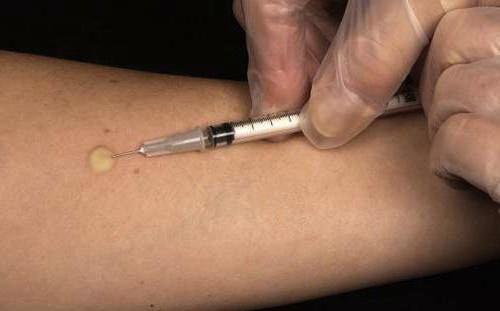The method of diagnosing tuberculosis is the Mantoux test
Tuberculin samples, which include the sampleMantoux, are a specific diagnostic test designed for mass screening of children and adolescents in order to detect tuberculosis. The sample is also performed for differential diagnosis of the tuberculosis process and detection of the degree of activity of the disease.
Mass tuberculin diagnostics are necessary for allchildren, starting from the age of one year. It is repeated every year, regardless of the results of the previous test. In even-numbered years, the sample is held on the right hand, in the odd ones on the left. The need to change the place of intradermal administration is due to the fact that when the solution is repeatedly injected into the same place, the reaction is enhanced by tuberculin induction.
The Mantoux test is carried out with a solution of purifiedtuberculin in standard dilution. To do this, use special syringes and needles for intradermal injection. The substance is administered intradermally on the inner surface of the forearm. With mass tuberculin diagnostics, needleless injectors can also be used, the advantage of which is the ability to diagnose a large number of children in a short time. It should also be noted the low traumatic character of injections performed with a needle-free method.
The results of the Mantoux test are evaluated in threedays, or rather, seventy-two hours. To evaluate the result of the reaction, measure the transverse diameter of the infiltrate formed at the injection site using a transparent ruler. The Mantoux test is considered negative if there is only a trace from the needle at the injection site and there is no infiltrate or papule completely. If the size of the infiltrate reaches 0.2-0.4 cm or the redness of any size is determined - the sample is considered doubtful. Positive is the Mantoux test in children with a reddening size of 0.5 cm or more. Hyperergic - with infiltrate sizes of more than 1.7 cm in children and adolescents, in adults more than 2.1 mm, as well as in the development of necrosis, vesicles, lymphangitis, regardless of the size of redness.
Assessment of the reaction of the body to intradermal administrationtuberculin is complicated by the fact that a positive reaction is possible both in infected mycobacteria and in immunized with BCG vaccine. For the correct evaluation of the reaction, the following should be considered:
- whether the child was vaccinated against tuberculosis and when;
- the intensity of the response to tuberculin during the previous survey and in previous years;
- the state of the child's health and information about his contact with patients with tuberculosis.
Thus, if a Mantoux sample is made, the reaction rate can vary widely.
Contraindications to the sample atmass tuberculin diagnostics are various skin diseases, acute viral and bacterial infections, chronic illnesses in the acute stage, allergic reactions, idiosyncrasy with significant skin manifestations, bronchial asthma, active rheumatism, epilepsy. It is contraindicated to conduct tuberculin diagnostics in children's groups during various quarantines. The time interval between any preventive vaccination, biological diagnosis and Mantoux test should be at least one month.
Individual tuberculin diagnostics is carried out in medical institutions with the aim:
- diagnosis and differential diagnosis of tuberculosis;
- determination of the activity of a specific tuberculosis process.
Individual diagnosis of the disease also uses the Mantoux test, which is carried out according to clinical indications with different non-standard doses of tuberculin.




